2010 DODGE GRAND CARAVAN towing capacity
[x] Cancel search: towing capacityPage 353 of 530
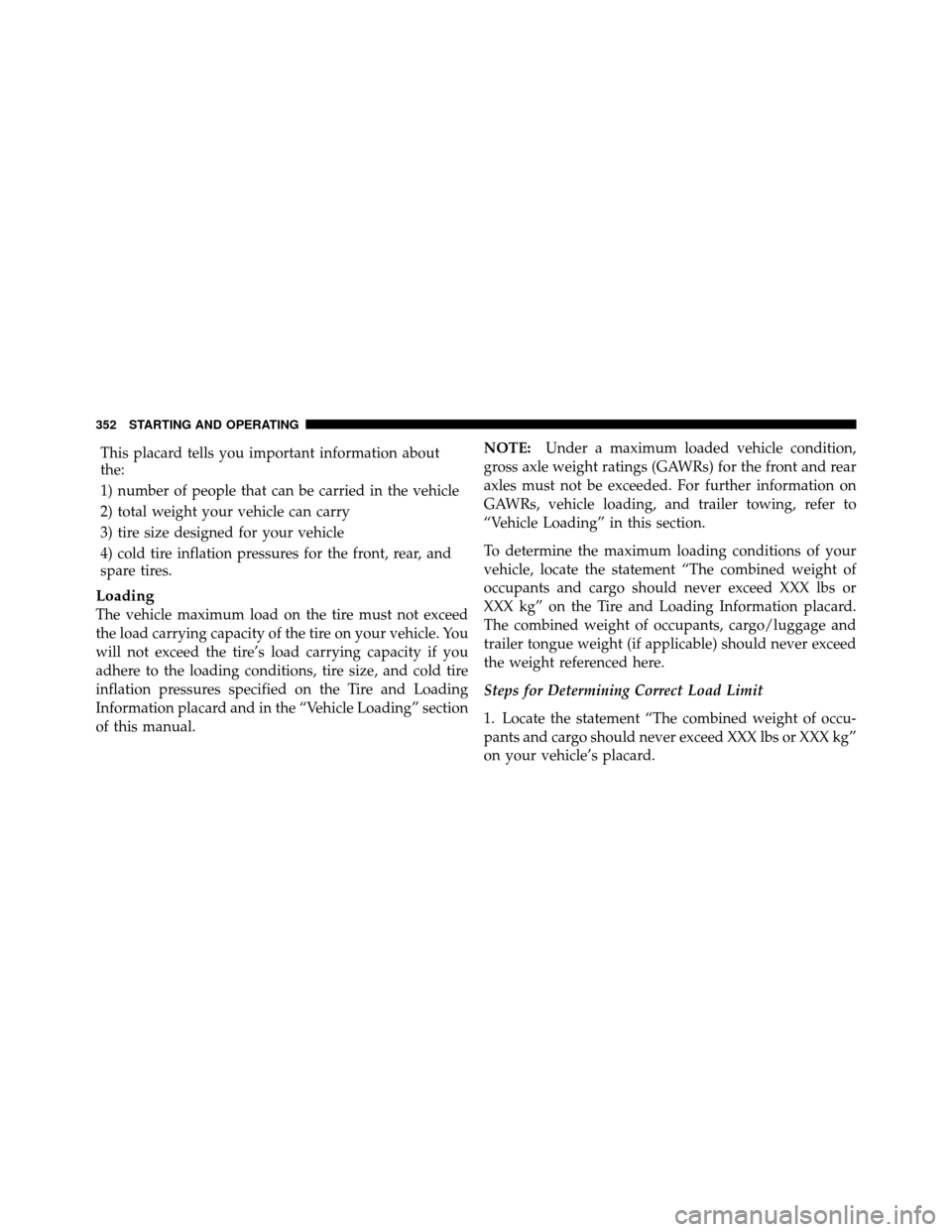
This placard tells you important information about
the:
1) number of people that can be carried in the vehicle
2) total weight your vehicle can carry
3) tire size designed for your vehicle
4) cold tire inflation pressures for the front, rear, and
spare tires.
Loading
The vehicle maximum load on the tire must not exceed
the load carrying capacity of the tire on your vehicle. You
will not exceed the tire’s load carrying capacity if you
adhere to the loading conditions, tire size, and cold tire
inflation pressures specified on the Tire and Loading
Information placard and in the “Vehicle Loading” section
of this manual.NOTE:
Under a maximum loaded vehicle condition,
gross axle weight ratings (GAWRs) for the front and rear
axles must not be exceeded. For further information on
GAWRs, vehicle loading, and trailer towing, refer to
“Vehicle Loading” in this section.
To determine the maximum loading conditions of your
vehicle, locate the statement “The combined weight of
occupants and cargo should never exceed XXX lbs or
XXX kg” on the Tire and Loading Information placard.
The combined weight of occupants, cargo/luggage and
trailer tongue weight (if applicable) should never exceed
the weight referenced here.
Steps for Determining Correct Load Limit
1. Locate the statement “The combined weight of occu-
pants and cargo should never exceed XXX lbs or XXX kg”
on your vehicle’s placard.
352 STARTING AND OPERATING
Page 354 of 530
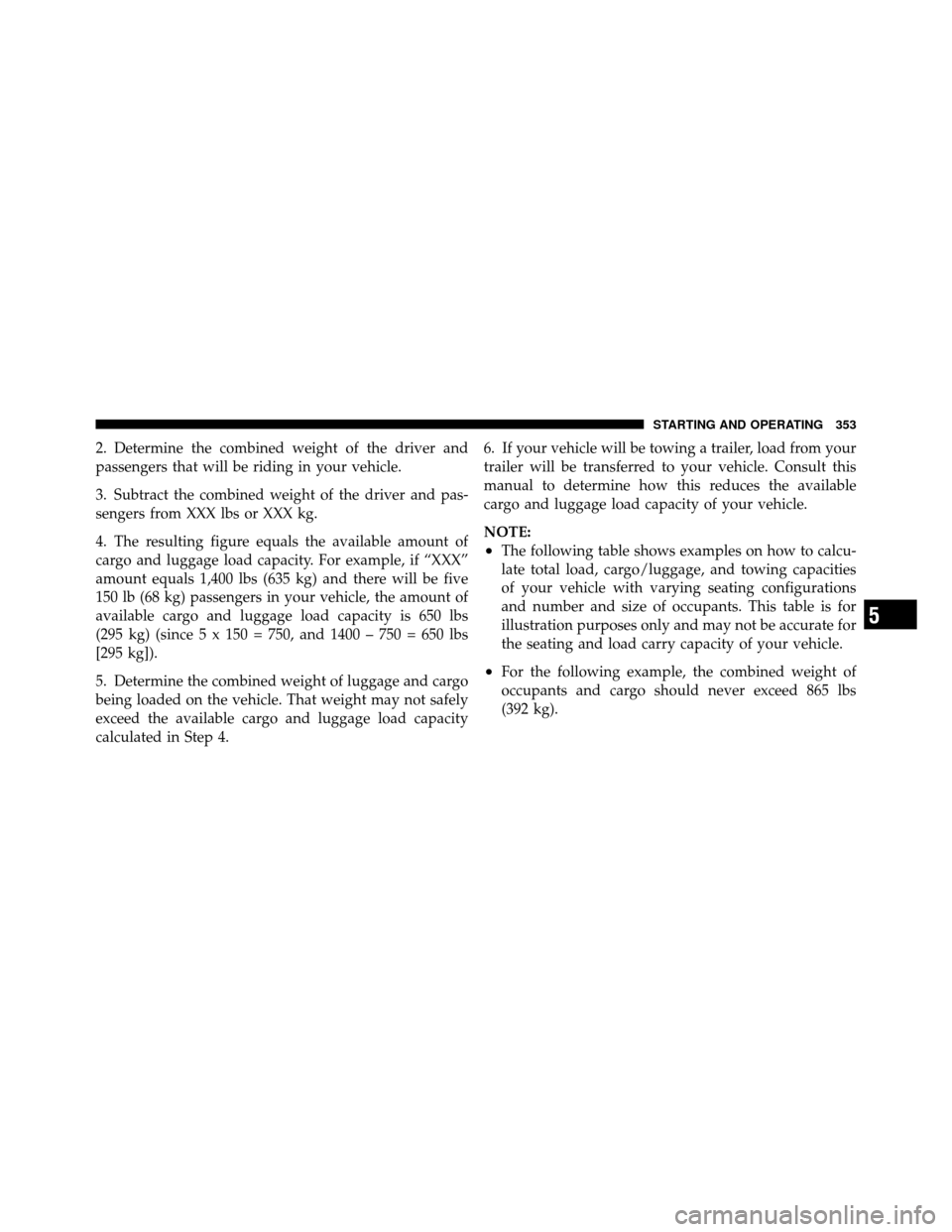
2. Determine the combined weight of the driver and
passengers that will be riding in your vehicle.
3. Subtract the combined weight of the driver and pas-
sengers from XXX lbs or XXX kg.
4. The resulting figure equals the available amount of
cargo and luggage load capacity. For example, if “XXX”
amount equals 1,400 lbs (635 kg) and there will be five
150 lb (68 kg) passengers in your vehicle, the amount of
available cargo and luggage load capacity is 650 lbs
(295 kg) (since 5 x 150 = 750, and 1400 – 750 = 650 lbs
[295 kg]).
5. Determine the combined weight of luggage and cargo
being loaded on the vehicle. That weight may not safely
exceed the available cargo and luggage load capacity
calculated in Step 4.6. If your vehicle will be towing a trailer, load from your
trailer will be transferred to your vehicle. Consult this
manual to determine how this reduces the available
cargo and luggage load capacity of your vehicle.
NOTE:
•The following table shows examples on how to calcu-
late total load, cargo/luggage, and towing capacities
of your vehicle with varying seating configurations
and number and size of occupants. This table is for
illustration purposes only and may not be accurate for
the seating and load carry capacity of your vehicle.
•For the following example, the combined weight of
occupants and cargo should never exceed 865 lbs
(392 kg).
5
STARTING AND OPERATING 353
Page 399 of 530

WARNING! (Continued)
4. Trailer tongue weight rating for that trailer hitch.
(This requirement may limit the ability to always
achieve the 10% to 15% range of trailer tongue weight
as a percentage of total trailer weight.)
Towing Requirements – Tires
•
Do not attempt to tow a trailer while using a compact
spare tire.
•Proper tire inflation pressures are essential to the safe
and satisfactory operation of your vehicle. Refer to
“Tires – General Information” in “Starting and Oper-
ating” for proper tire inflation procedures.
•Check the trailer tires for proper tire inflation pres-
sures before trailer usage.
•Check for signs of tire wear or visible tire damage
before towing a trailer. Refer to “Tires – General
Information” in “Starting and Operating” for the
proper inspection procedure.
•When replacing tires, refer to “Tires – General Infor-
mation” in “Starting and Operating” for proper tire
replacement procedures. Replacing tires with a higher
load carrying capacity will not increase the vehicle’s
GVWR and GAWR limits.
Towing Requirements – Trailer Brakes
•
Donot interconnect the hydraulic brake system or
vacuum system of your vehicle with that of the trailer.
This could cause inadequate braking and possible
personal injury.
398 STARTING AND OPERATING
Page 400 of 530
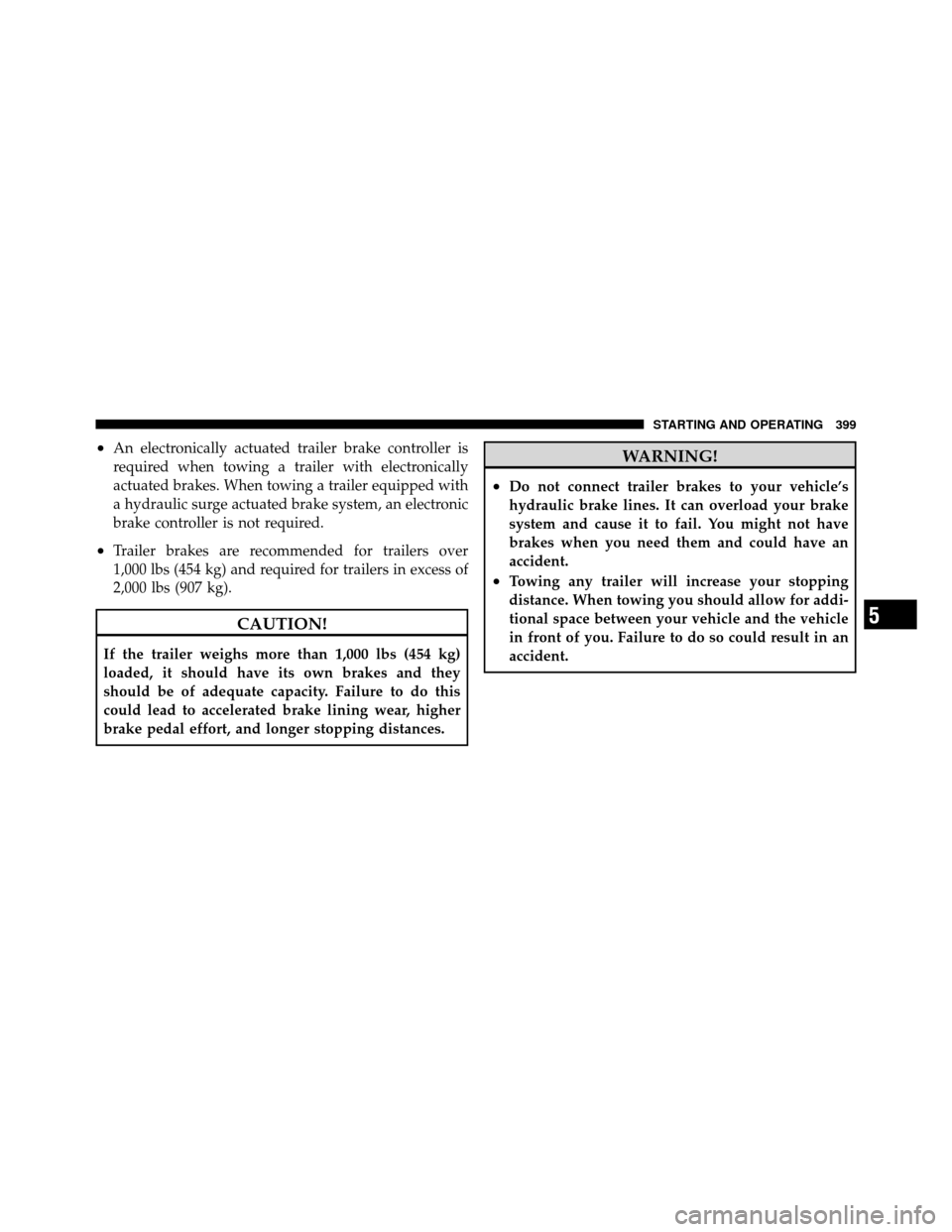
•An electronically actuated trailer brake controller is
required when towing a trailer with electronically
actuated brakes. When towing a trailer equipped with
a hydraulic surge actuated brake system, an electronic
brake controller is not required.
•Trailer brakes are recommended for trailers over
1,000 lbs (454 kg) and required for trailers in excess of
2,000 lbs (907 kg).
CAUTION!
If the trailer weighs more than 1,000 lbs (454 kg)
loaded, it should have its own brakes and they
should be of adequate capacity. Failure to do this
could lead to accelerated brake lining wear, higher
brake pedal effort, and longer stopping distances.
WARNING!
•Do not connect trailer brakes to your vehicle’s
hydraulic brake lines. It can overload your brake
system and cause it to fail. You might not have
brakes when you need them and could have an
accident.
•Towing any trailer will increase your stopping
distance. When towing you should allow for addi-
tional space between your vehicle and the vehicle
in front of you. Failure to do so could result in an
accident.
5
STARTING AND OPERATING 399
Page 514 of 530
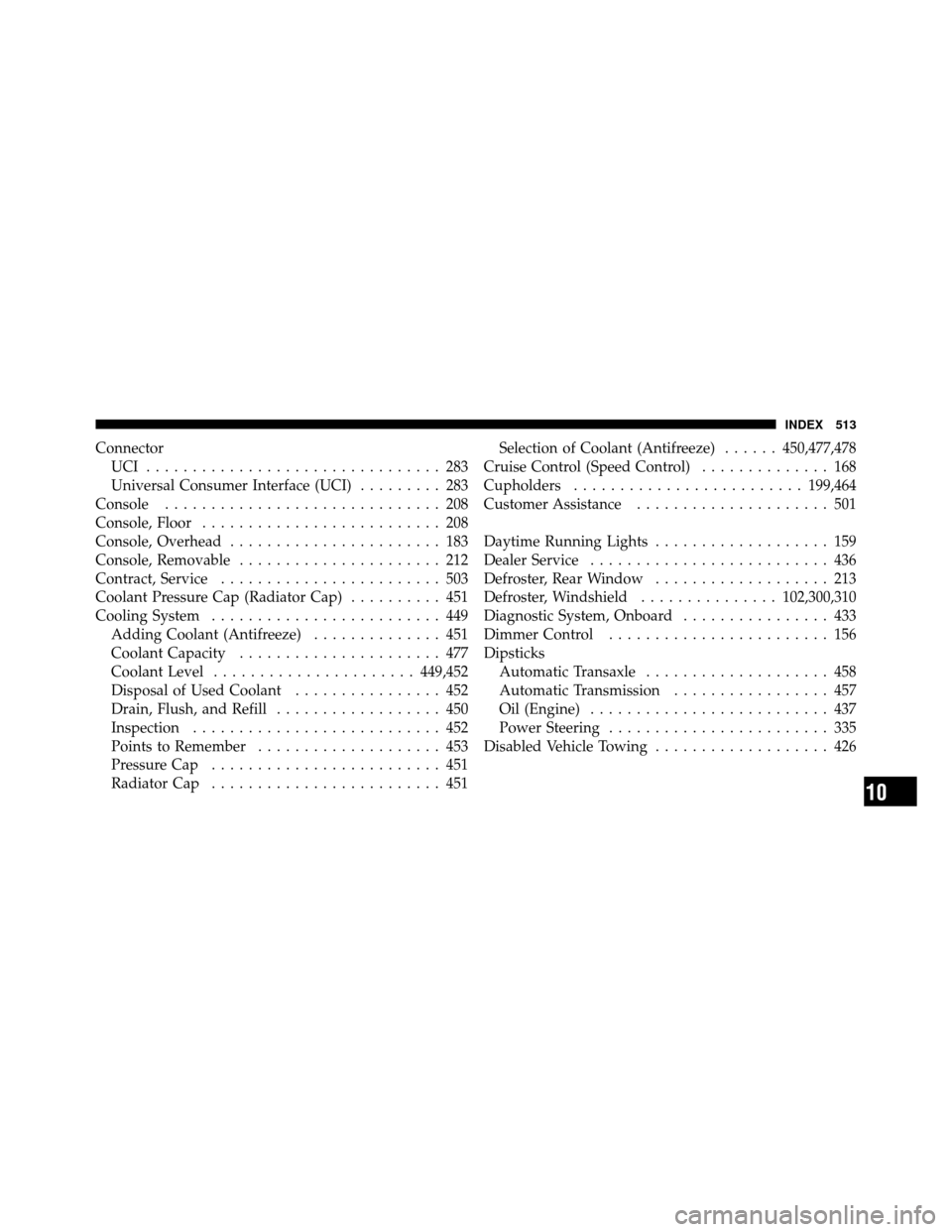
ConnectorUCI ................................ 283
Universal Consumer Interface (UCI) ......... 283
Console .............................. 208
Console, Floor .......................... 208
Console, Overhead ....................... 183
Console, Removable ...................... 212
Contract, Service ........................ 503
Coolant Pressure Cap (Radiator Cap) .......... 451
Cooling System ......................... 449
Adding Coolant (Antifreeze) .............. 451
Coolant Capacity ...................... 477
Coolant Level ...................... 449,452
Disposal of Used Coolant ................ 452
Drain, Flush, and Refill .................. 450
Inspection ........................... 452
Points to Remember .................... 453
Pressure Cap ......................... 451
Radiator Cap ......................... 451 Selection of Coolant (Antifreeze)
......450,477,478
Cruise Control (Speed Control) .............. 168
Cupholders ......................... 199,464
Customer Assistance ..................... 501
Daytime Running Lights ................... 159
Dealer Service .......................... 436
Defroster, Rear Window ................... 213
Defroster, Windshield ...............102,300,310
Diagnostic System, Onboard ................ 433
Dimmer Control ........................ 156
Dipsticks Automatic Transaxle .................... 458
Automatic Transmission ................. 457
Oil (Engine) .......................... 437
Power Steering ........................ 335
Disabled Vehicle Towing ................... 426
10
INDEX 513
Page 527 of 530
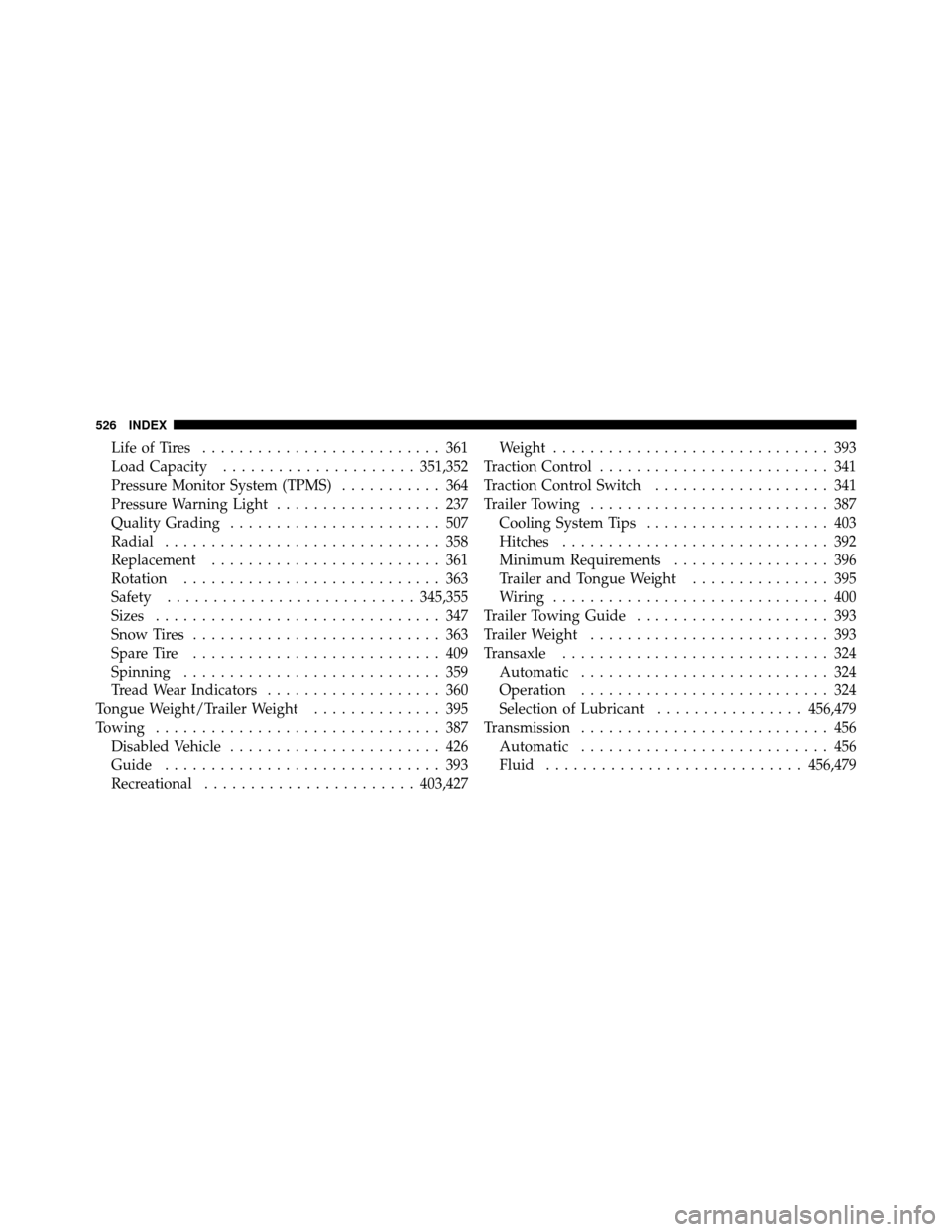
Life of Tires.......................... 361
Load Capacity ..................... 351,352
Pressure Monitor System (TPMS) ........... 364
Pressure Warning Light .................. 237
Quality Grading ....................... 507
Radial .............................. 358
Replacement ......................... 361
Rotation ............................ 363
Safety ........................... 345,355
Sizes ............................... 347
Snow Tires ........................... 363
Spare Tire ........................... 409
Spinning ............................ 359
Tread Wear Indicators ................... 360
Tongue Weight/Trailer Weight .............. 395
Towing ............................... 387
Disabled Vehicle ....................... 426
Guide .............................. 393
Recreational ....................... 403,427Weight
.............................. 393
Traction Control ......................... 341
Traction Control Switch ................... 341
Trailer Towing .......................... 387
Cooling System Tips .................... 403
Hitches ............................. 392
Minimum Requirements ................. 396
Trailer and Tongue Weight ............... 395
Wiring .............................. 400
Trailer Towing Guide ..................... 393
Trailer Weight .......................... 393
Transaxle ............................. 324
Automatic ........................... 324
Operation ........................... 324
Selection of Lubricant ................456,479
Transmission ........................... 456
Automatic ........................... 456
Fluid ............................ 456,479
526 INDEX